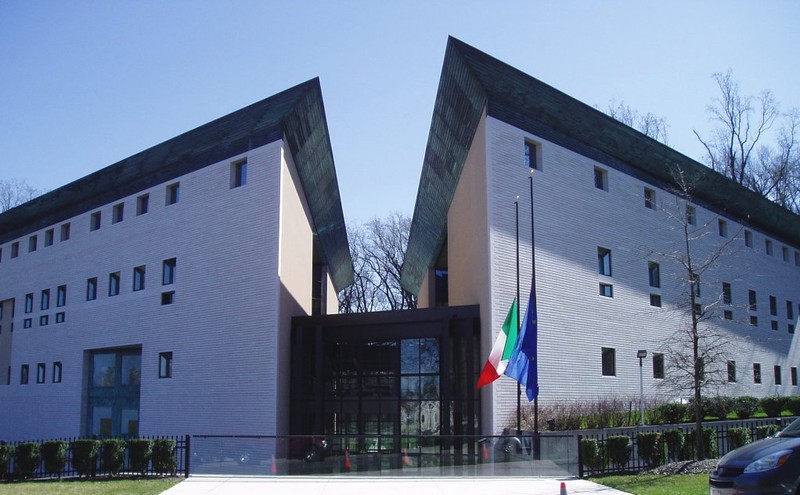Embassy of Italy
Introduction
Text-to-speech Audio
Images
The Italian Embassy building is divided in two to symbolize the way the Potomac River cuts through D.C. Photo by SimonP at English Wikipedia.

Backstory and Context
Text-to-speech Audio
The Italian Embassy maintains relations with the United States, one of Italy’s key allies. Together, the two countries emphasize trade and economics, along with cultural and scientific initiatives. The Italian Embassy identifies “three pillars” that strengthen its alliance with the United States: the United Nations, to maintain international order; NATO, a collective defense agreement; and Euro-Atlanticism, the idea that countries on both sides of the Atlantic Ocean should hold a strong bond. The Embassy coordinates a network of organizations that support Italian nationals as well as the numerous Italian communities and descendants in the United States. Consulates are located in Boston, Chicago, Detroit, Philadelphia, Houston, Los Angeles, Miami, New York City, and San Francisco. Five trade agencies and three Italian Tourist Board offices are stationed throughout the United States. With Italians comprising the fourth-largest ethnic group of European origin in the United States, the Italian Embassy plays a role in promoting Italian culture, heritage, tourism, and citizenship. Five Cultural Institutes, along with museums, universities, and festivals, foster American-Italian cultural exchange.
The United States established relations with Italy in 1861, when the Italian states unified under King Victor Emmanuel II. The rise of fascism led to Benito Mussolini establishing a fascist dictatorship in 1919. The United States severed relations with Italy in 1941 after Mussolini's regime declared war on its former ally and supported Nazi Germany during World War II. In 1944, the United States reestablished relations to assist Italy in forming a republican state, which officially formed in 1946 and continues today. Italy joined the European Union and became a founding member of the North Atlantic Treaty Organization (NATO).
The Italian Embassy was first established at 2700 16th Street, NW, in Washington, D.C. They constructed an Italian Renaissance Revival building in 1925, on land purchased from Mary Foote Henderson, who built around a dozen embassies along this street. Today, the former Italian Embassy is being transformed into a luxury apartment building.
A competition was held to choose an architect to design the building and oversee construction of it. The winning architect was Piero Sartogo. He drew inspiration from design concepts of Pierre Charles L’Enfant, the eighteenth century architect of Washington, D.C. The building is split in two equal pieces, reflecting the way the Potomac River divides the city from surrounding states. Sartogo’s contemporary design is imbued with traditional Italian ways of life and community gathering. The embassy’s large atrium, capable of holding 1,000 people, functions much like an Italian piazza. Throughout the embassy, modern art is joined by Roman artifacts and Italian Renaissance paintings. Though the building is not open for tours, it is occasionally open for events, such as the EU Open House held once a year.
Cite This Entry
Trowbridge, David J., Emily Beatty, and Pamela Curtin. "Embassy of Italy ." Clio: Your Guide to History. October 22, 2017. Accessed April 29, 2025. https://theclio.com/tour/217/7
Sources
Ambasciata d'Italia: Washington DC. “The Embassy.” Accessed October 2017. http://www.ambwashingtondc.esteri.it/ambasciata_washington/en/aboutus
Ambasciata d'Italia: Washington DC. “Italian and Italian-American communities.” Accessed October 2017. http://www.ambwashingtondc.esteri.it/ambasciata_washington/en/italiaeusa/italiani_italo-americani.html
Ambasciata d'Italia: Washington DC. “Our Building.” Accessed October 2017. http://www.ambwashingtondc.esteri.it/ambasciata_washington/en/aboutus/20100414_chancery.html.
Ambasciata d'Italia: Washington DC. “Political Relations.” Accessed October 2017 http://www.ambwashingtondc.esteri.it/ambasciata_washington/en/italiaeusa/cooperazione%20politica.html
Central Intelligence Agency. “The World Factbook: Italy.” January 12, 2017. Accessed October 2017. https://www.cia.gov/library/publications/the-world-factbook/geos/it.html.
D.C. Planning. “District of Columbia Inventory of Historic Sites.” Historic Preservation Review Board. Government of the District of Columbia. September 30, 2009. Accessed October 2017. https://planning.dc.gov/sites/default/files/dc/sites/op/publication/attachments/Inventory%202009%200%20Alpha%20Version%2003%2011.pdf
Lerner, Michele. “Luxury apartments to emerge from former Italian Embassy in D.C.” Washington Post. November 22, 2016. Accessed October 2017. https://www.washingtonpost.com/news/where-we-live/wp/2016/11/22/luxury-apartments-to-emerge-from-for...
U.S.
Department of State. "A Guide to the United States' History of
Recognition, Diplomatic, and Consular Relations, by Country, since 1776:
Italy." Office of the Historian. Accessed October 2017. https://history.state.gov/countries/italy
U.S. Department of State. "U.S. Relations
with Italy." Bureau of European and Eurasian Affairs Fact Sheet. July 21,
2016. Accessed October 2017. https://www.state.gov/r/pa/ei/bgn/4033.htm
U.S. Embassy and Consulates in Italy. “Policy and History.” Accessed October 2017. https://it.usembassy.gov/our-relationship/policy-history/

